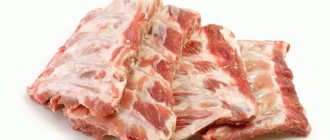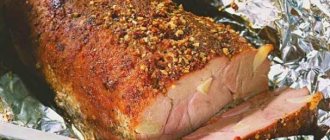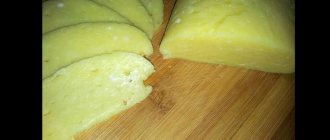Dried meat
This meat is a wonderful product for lovers of hiking and extreme conditions, and athletes. It is very easy and quick to have a snack on the go, and at the same time it will provide you with a quick surge of strength and energy. And this means a lot in traveling conditions.
In addition, dried meat can be easily turned into regular meat. To do this, just fill it with hot water and leave for an hour until it returns to its previous state. Or you can simply add a piece of this product when cooking soup.
How to cook dried meat
It is quite easy to prepare at home. It's a simple process. Lamb and beef are good for this. It's better not to take pork. It does not make a normal product.
Of course, the meat must be fresh. This is the main condition. In addition, it should be completely non-greasy, without streaks.
The beef needs to be cut into pieces. It is better if their thickness is no more than one centimeter. But even if you end up with thicker pieces, that’s okay. The cooking process will just take longer.
The thinner you cut it, the faster your meat will dry out. Even when preparing, you need to consider for what purpose you are preparing such a product. If you use it at home, feel free to make thick pieces. But if you are going to take it on a hike, then the pieces must certainly be thin. This will make it easier to use it on the road. Agree that a thick piece will be difficult to chew.
Meat abundance
You can make dried preparations at home without much effort. In Russian regions, the most popular are dried beef, poultry and pork products. Each product has a different taste, cooking technology, and duration of the drying process. The delicacy takes the longest to prepare from beef, since it is the densest raw material. The fastest option is chicken or turkey. It will take no more than 1 week for one half of a chicken fillet to dry under natural conditions in a ventilated room.
Beef basturma
To pamper your stomach with delicious basturma , you don’t have to run to the supermarket or market and shell out a round sum for a small piece of the aromatic delicacy. Without much effort, you can cook beef basturma at home and please yourself and your household.
For this you will need fresh beef tenderloin. Rinse the tenderloin, dry it, roll it in salt and leave it in the refrigerator for a week. In this case, you need to turn the meat over every day and add fresh salt to the exposed areas of the meat. When it becomes dry and hard, you will need to rinse it thoroughly, leave it in cold water overnight, and then put it under a press for a day.
While the meat is draining and compressing, you need to prepare the spice paste. To do this, pour half a kilo of ground fenugreek seeds with warm water to the consistency of thick sour cream. Leave the mixture overnight. Then squeeze in 300 g of young garlic (old garlic will not work because the smell is too strong), add 150 g of ground paprika and the same amount of chili pepper.
Mix the resulting mixture thoroughly; if it turns out too thick, add more warm water. Remove the meat from under the press and coat it with a thick layer (at least 0.5 cm) of the resulting paste. You can further dry the meat in several ways. You can keep the basturma in the oven so that the paste dries a little, and then hang it in a cool place for subsequent drying.
It is possible to hang the meat immediately, but here it is necessary to take into account that the paste can flow and drip, so you need to place a plate under the workpiece or lay several layers of paper.
If there is any paste left, then under no circumstances should you throw it away. During the drying process, the meat may become exposed in some places, and these places will need to be covered. The product is completely ready in 2-4 weeks. By this time, the paste should have hardened and the tenderloin inside will be dark.
Dried chicken fillet
This delicacy is made faster than from beef or pork. For the recipe, you can use chicken, turkey, duck or goose fillet. It is better to dry the workpiece indoors, with constant ventilation. It may turn out too dry in the oven. The ingredients needed are:
- poultry fillet - from 0.5 kg and more;
- sweet paprika - 2 tbsp. l.;
- black pepper - 1 tbsp. l.;
- salt - 2-3 tbsp. l.;
- garlic - to taste.
Rinse the fillet thoroughly, dry with a napkin and place in a suitable container - a baking dish or a deep bowl. Sprinkle generously on all sides with seasoned salt, pepper and garlic. Cover the top of the vessel with film and place a board with a weight on top. Place the preparation in the refrigerator for a day. All this time, the meat will release liquid; there is no need to drain it.
After 24 hours, take out the workpiece, rinse it from salt, dry it with a paper napkin, roll it again in spicy salt and garlic, put it in the refrigerator, wrapping it in gauze. The semi-finished product remains in this position for another day. After 24 hours, the delicacy can be consumed immediately or dried for several days. Wrap the finished product in parchment and store in the cold.
Dried pork
This pork delicacy is ideally prepared in the oven. It cooks faster than when dried under natural conditions, the only thing is that the product turns out drier and more brittle.
For it you will need:
- pork pulp - 1 kg;
- mixture of dry vegetables (onions, carrots, garlic, dill) - 3 tbsp. l.;
- coarse salt - 3 tbsp. l.;
- aromatic herbs, herbs, spices - to taste.
Remove tendons, films, and fat from meat. Wash and dry. Mix all the spices and seasonings, roll the meat in the resulting mixture and refrigerate for two days. Turn the meat twice a day to ensure even salting. After 48 hours, the meat must be removed, cut into thin long strips (no thicker than 1 cm), placed in one layer on a wire rack or, if using a baking sheet, on a layer of parchment. Heat the oven to 50 degrees and put the meat there. Leave the door slightly open. Drying will take at least ten hours.
Beef biltong
This is a quick and easy option for drying meat at home. The recipe for dried beef is simple and does not require much effort. For it you need to take one kilogram of pulp, wash and dry, cut along the fibers into thin strips. Beat the pieces, sprinkle with vinegar and rub with a mixture of the following spices: two tablespoons of salt, a teaspoon each of coriander, black pepper and sugar. The workpiece is placed in a stainless container, pressure is placed on top and put in the cold for 12 hours.
Dilute vinegar in a ratio of one to six. After 12 hours, remove the meat from under oppression, put it in a vinegar solution for five minutes, then rinse each piece of the workpiece well with water and hang it in a ventilated room for a day.
You can improvise with the choice of meat . Lamb and pork also work well ; You can experiment with turkey.
Dried meat: homemade recipe
The meat must be cut across the fibers so that later they do not interfere so much during the eating process. We put the prepared pieces into a bowl, and we ourselves begin to prepare the brine, which we will need later.
To prepare it we need a mixture of peppers. You can purchase a set of a combination of several types: red, black, white, green. But you can also obtain such a mixture yourself by grinding individual types in a coffee grinder. The result will be no worse. We will also need salt, bay leaf, soy sauce, sugar and boiling water.
For two kilograms of beef, the amount of ingredients will be as follows:
- Two full teaspoons of table salt.
- Also two teaspoons of pepper mixture.
- Fifty milliliters of soy sauce will be enough.
- A teaspoon of granulated sugar.
- A few chopped bay leaves.
- You can also add some herbs for the meat.
Mix all these ingredients in one bowl and pour a glass of boiling water. The resulting solution must be stirred so that the salt is completely dissolved.
Next, pour brine over our meat, mix everything so that each piece receives its own portion of salt and spices. Cover the pan with a lid; no excess air should enter it. And we put it in the refrigerator for three days. During this time, the meat will soften and become saturated with salt and spices.
Sugar makes meat taste more tender, enhancing its aroma. Salt provides protection against the development of microorganisms. And soy sauce gives it a special flavor. It makes dried meat at home much tastier.
Jerky
Almost all nations have recipes for preparing such meat with their own hands. Today, the most popular are basturma (Turkic origin) and biltong (African origin).
Basturma
To treat yourself to basturma, take fresh beef tenderloin and stock up on chaman (fenugreek seeds). Rinse the beef, dry it, roll it thoroughly in salt. Leave in the refrigerator for 7-10 days, turning over daily and adding dry salt to the exposed areas. When the tenderloin becomes dry and hard to the touch, rinse it, soak it overnight in cold water and put it under a press for a day.
Meanwhile, pour 600 g of ground fenugreek seeds with warm water until you obtain the consistency of thick sour cream. Leave it overnight. Squeeze 300 g of garlic into the mixture, add 150 g of ground chili and paprika. Mix well, add water if necessary. Remove the beef from the press and coat completely with paste in a layer no thinner than 0.5 cm.
There is no single answer to the question of how to properly dry meat prepared in this way. You can lightly hold it in the oven to let the paste dry, and then hang it in a cool place. You can hang it right away, keeping in mind that the paste may run and drip a little at first.
In any case, bare areas will need to be sealed. Therefore, do not throw away the paste remaining after the initial coating of the delicacy. Basturma will be ready after 2-4 weeks, when the paste hardens and the meat inside becomes dark.
Biltong
This option is quicker and easier to prepare. Mix 2 tbsp. l. salt, 1 tbsp. l. ground coriander, 1 tsp. sugar and ground black pepper. Wash 1 kg of meat, dry it, cut along the grain into strips no more than 1 cm thick. Lightly beat them, sprinkle with 6% vinegar, sprinkle with the mixture on all sides, put in a stainless container, set pressure and place in the cold for 12 hours.
How to grill shish kebab outdoors without a grill and skewers?
Dilute 6% vinegar with clean water in a ratio of 1:6. Place the meat in the solution for 5 minutes, thoroughly rinse each piece in it and hang it in a well-ventilated place for about a day.
Don't dry it out! Biltong is a dry-cured product, and in a brittle state it will no longer be as tasty. But the error cannot be corrected.
Cut the finished pieces into thin strips across the grain and enjoy.
The classic basturma recipe involves the use of beef. You can improvise with biltong. The inhabitants of Africa made such a dish from any available meat, even elephant. In modern conditions, both dried beef and dried lamb will be equally tasty.
Drying the meat
There is a special meat dryer that will facilitate the cooking process at home. After the beef has been in the brine, it can be placed in the dryer. You can also cook dried meat using the oven. In any case, the result is good.
If you have a meat dehydrator, place the beef pieces on wire racks. The bottom layer of meat can be laid from larger pieces, since it dries out faster.
Oven drying
If you decide to cook dried meat in the oven, then this is done as follows.
The oven must be preheated to seventy degrees. Beef should be cooked until completely dry. During the process, you need to keep the oven slightly open, since the moisture will need to escape somewhere.
Remember to dry the meat with the gas turned off. Periodically, the baking sheet with beef must be taken out and the oven preheated. Then return the meat to its place.
You will spend about a day drying. If you cook the meat less, it will simply lose some of the moisture, but will not dry out completely. You will receive jerky. It won't keep for very long. Although quite suitable for a two-week trip. At first it can be eaten without additional cooking, but after a week and a half it is better to use it for making soups or frying.
For long-term storage without refrigeration, the meat must dry out to a stone state. The optimal temperature for the cooking process is seventy degrees. You shouldn’t exceed it, but you shouldn’t reduce it either. At high temperatures, meat can cook to an unacceptable state.
Dried meat should be stored in a dry place without access to air in the dark. This is a very important condition. The best option would be to pack it either in plastic bags or glass jars.
Once again about dried meat - report with photos (part 1)
Good afternoon to all fellow survivors. And a special greeting to the comrades (if any are present here) on this wonderful holiday! Happy spring holiday, girls!
In honor of the holiday, I want to dedicate this blog entry to my faithful fighting friend, her name is Larisa Sergeevna.
Special respect to Larisa for the fact that she is always ready to accept all sorts of innovations that I regularly find: - Let's go fishing? - Let's! - And you drive! - Easily! - How about we build a boat? - What a damn thing to do! “Then hold this board while I drill.” - I’m holding it! - Let's dry the meat? - Easily! - Then pour it! - Already!!!
That's what we'll talk about today. I have been interested in the topic - “how to dry meat at home” for a couple of months now, after reading the publications of Alexander Skat, Alexey Nikitin... Then I found a couple more notes in the “live journal”, here and here. I watched a few more videos on YouTube (I don’t give links to them, there was little useful there, and most importantly, there was more confusion from an overabundance of information).
By the way, I’ll say right away the main thing that I understood: there is no single universal recipe in this topic. Rather, there is a certain set of principles - and a lot of room for imagination and creativity. You can salt the meat “dry”, you can salt it in brine (brine). You can sprinkle the spices right away, or you can roll them in the spices later. You can dry it in the breeze, or you can dry it in the refrigerator. Can be consumed with beer, or with vodka. )))
Okay, I won't get carried away with my thoughts. Get to the point! I will provide photos with dates to make the process clearer.
February 20th. For the first sample, about a kilo of beef and one and a half kilos of pork were taken. Beef - something like a tenderloin (thin edge?), Pork - neck, lean, with a small strip of fat.
Spices were found in abundance in household supplies (please note that if you are storing stewed meat, pasta, cereals, it is important not to forget the spices. At least the basic set: bay leaf, black and red pepper, be sure to have more salt! If “D-Day” comes and “ hour H" - most likely there will be no time to remember about spices... but it’s difficult to do without them. Therefore, when stocking up on stew and pasta, don’t forget about pepper and salt!)
Looking ahead, I’ll be honest: I went too far with the spices the first time. It was hard to resist pouring in another handful! Black and allspice, red paprika and red hot, and chili... Cloves and coriander and bay leaf... Grind everything in a mill (or coffee grinder)... mix well!
The base is simple table salt. All sources emphasize that it is advisable to use coarse salt, and always plain, non-iodized salt. I understand that iodized salt can cause bitterness. You need about 40-50 grams of salt per kilo of meat. I sprinkled it “by eye”, remembering the words of my grandfather (and he, an old fisherman, understood something about this, since he was 14 years old he had been salting fish) - “a fish will always take as much salt as it needs!” Yes, there is no fish here. But I think the system is the same with meat. Expressing the old thought in “smart words”, I will throw out the terms: “autolysis”, “protein-lipid complexes”, “osmosis”... Those interested will refer to reference books or Wikipedia. But the fact is that the grandfather was right: the salt does not form a crust on the finished dry product, and everything tastes fine - especially considering that the finished product will most likely be consumed just with beer, about one slice of meat per mug of foam!)) )
Then... The mixture of salt and spices seemed too dry to me, you could have just added a drop of water. But there were pharmaceutical bottles of alcohol in the supplies. I thought - after all, the meat is raw... and there is some kind of disinfection here. In short, 100 grams of 95% alcohol was added. I don't know how this could affect the taste. Some people add cognac, I read. But we’d rather take the cognac orally, and here it’s alcohol.
Roll the meat in this wet mixture of salt, spices and alcohol... put it in a suitable container and put it in the refrigerator overnight.
I have beef in one pan and pork in the other.
February 21 In the refrigerator for a day, pressure was added, the meat gave juice. It's exactly what you can see in the photo.
Many recipes advise draining the juice. But, to be honest, I was just sorry - there were so many delicious spices there! In addition, from experience in salting fish, we never drain the released liquid (the so-called brine).
True, there were also doubts - after all, we wash the fish after salting, but we did not plan to wash the meat (again, to preserve the spices) ... In short, we decided to try salting further in the brine - remembering the ancient idea that “it will take so much salt, as much as needed) - see above.
Then, for six days it stood like that in the refrigerator under oppression. They regularly took out, checked and turned over the pieces. An important point is that in brine, the meat quickly becomes “cold” (hardens and loses flexibility). I had concerns that the pieces would remain rolled into a ring, in the shape of a pan (later it turned out that my doubts were in vain, the suspended meat would quickly “sag” and take the shape of a sausage). However, on about the third or fourth day, I transferred the meat to another (elongated) dish, such as a duckling dish - and all together, pork and beef. And mixed the liquid with the seasonings. Yes, I admit that this is “not fashionable”, I confess! But there, in any case, everything was already salted and alcoholized... I’m sure the taste didn’t get worse from this (and practice has confirmed this!)
Here is the next photo, although not of high quality, but EXIF confirms to us that a week has passed, and it’s already the 28th :
Shortly before the experiment, an improvised drying rack was made especially for the balcony - a block was nailed to the ceiling, with meat hooks screwed into it. By the way, I knitted the meat using a black, harsh thread, purchased in reserve at “survive.rf” - that’s where the nylon fishing thread came in handy!
Our balcony is glazed and ventilated. There is a net on the window. There are no flies, there is air flow.
February 26
There is no mistake in the dates - just one piece of beef was very small, and it only dried for a day ! That was enough... well, almost. In the photo above you can see that the meat inside the piece is still reddish - it’s not dry enough. But I really wanted to try it! And we were not disappointed. In short, if you like rare steak, this is it!
From already February 29
We also try the pork - it feels dry to the touch. But you can also dry it - fortunately, there are two pieces of each type, you can experiment.
But I warn you in advance: once you try, cut off just a piece, it’s very difficult to stop! Very tasty!
To be continued! The time has come for the dried chicken breast. I'll try to report back tomorrow! PS I was actually going to post this report on March 8th, that’s why I started with congratulations to the girls and other things... But they didn’t let me finish, the meat eaters came, as they sensed! Therefore, I post it in parts, as I taste it. Really, it turns out very tasty. And it’s terribly offensive - why the hell didn’t we learn to do this before??? How much money is spent on all sorts of snacks and beer snacks? But it’s so easy, with minimal costs, to make an awesome product - which does not spoil, and is without GMOs and glutamate, and is made according to the classic recipe (from the time of Noah’s Ark), and is suitable for future troubled times... I strongly recommend it!
Advice from experts
- Thinly sliced meat dries faster and is more convenient to eat while hiking.
- The finished beef can be kept on paper for about a day before packaging. This is done so that the moisture evaporates. Experience shows that this increases the shelf life of meat without refrigeration. And in weather conditions this is very important.
- While cooking meat in the oven, you can place a baking sheet under the rack. This will help keep it clean. In addition, the entire oven will have to be washed, since it retains the smell persistently.
- Gnawing on ready-made slices of dried meat is very tasty. But you need to be careful and take care of your teeth.











